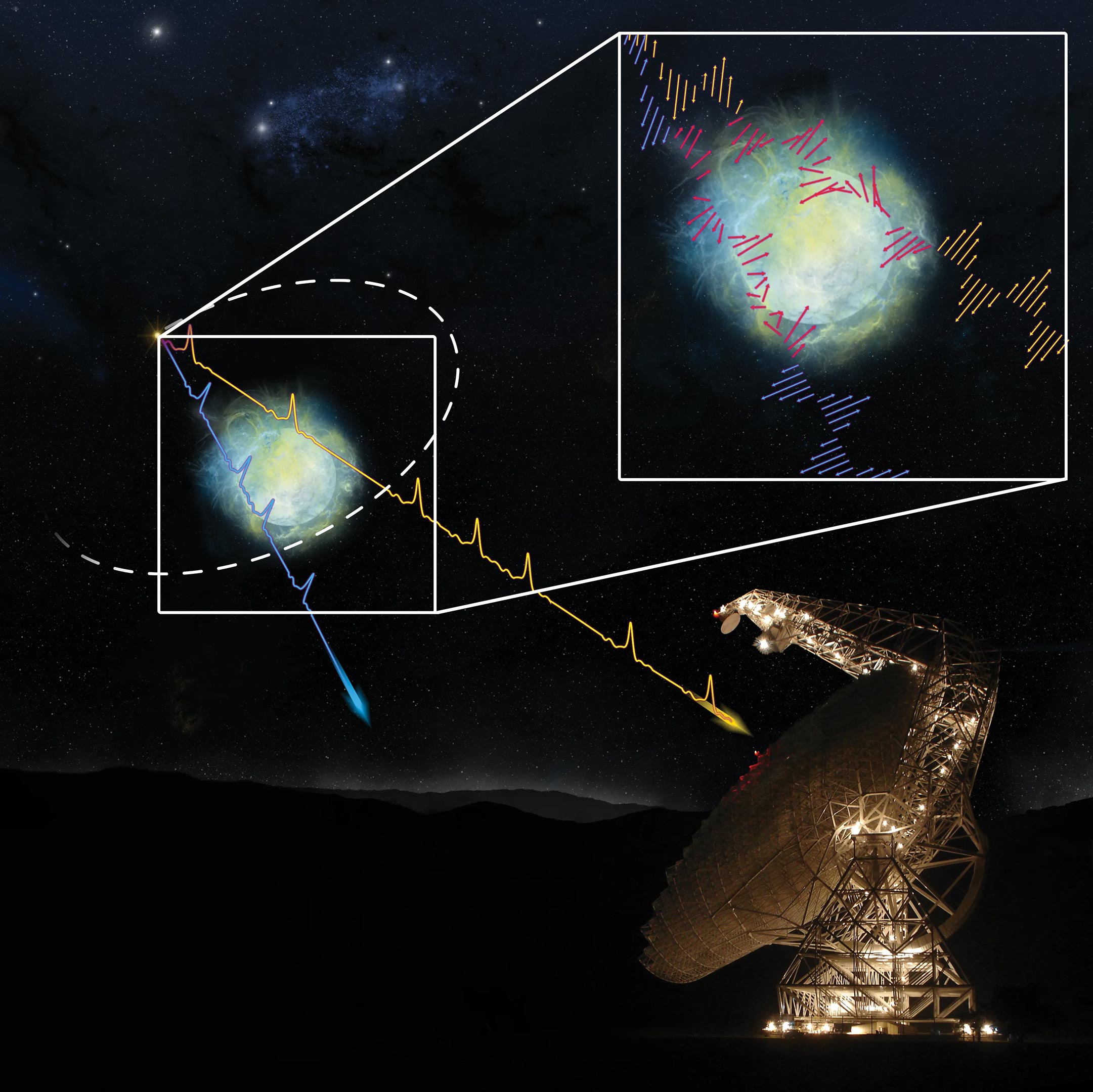Teleskop Green Bank był w stanie obserwować zmiany kierunku fal z FRB20190520B widzianych przez soczewkę atmosfery masywnej gwiazdy. Źródło: NSF/GBO/P.Vosteen.
Tajemniczy obiekt kosmiczny w odległej galaktyce karłowatej wytwarza szybkie rozbłyski radiowe (FRB), a nowe badania ujawniają rzadkie środowisko astronomiczne wokół ich źródła, w którym pola magnetyczne skręcają się i falują. Jest to pierwsza obserwacja odwrócenia pola magnetycznego z FRB, co wskazuje, że niektóre FRB mogą pochodzić z układów podwójnych gwiazd.
W sercu galaktyki karłowatej oddalonej o cztery miliardy lat świetlnych znajduje się tajemnicze ciało kosmiczne, które wytwarza wybuchy energii trwające zaledwie kilka milisekund. Nowe badania tego szybkiego rozbłysku radiowego (FRB) ujawniły rzadko obserwowane środowisko astronomiczne wokół jego źródła, w którym pola magnetyczne skręcają się, rotują i falują w czasie. Jest to pierwsze wykrycie odwrócenia pola magnetycznego zaobserwowane przez FRB i po raz pierwszy zaobserwowano takie zachowanie w innej galaktyce.
Astronomowie od dawna poszukiwali tajemniczego pochodzenia FRB. Te tajemnicze, ulotne impulsy radiowe, odkryte w 2007 roku przez zespół naukowców z West Virginia University, są uważane za tajemnice wszechświata, ponieważ przyczyna i pochodzenie FRB są nadal nieznane.
Międzynarodowy zespół kierowany przez asystentkę naukową West Virginia University, Reshmę Annę Thomas, znalazł pierwszy dowód na odwrócenie pola magnetycznego w jakimkolwiek FRB podczas kampanii. Odkrycie to potwierdza również ideę, że przynajmniej część FRB pochodzi z układu podwójnego, który jest układem dwóch gwiazd krążących wokół siebie.
Anna-Thomas mówi: „Mieliśmy nadzieję wykryć wysoką wartość skali wirowania, która wskazuje na intensywne namagnesowanie[{” attribute=””>plasma environment but surprisingly, we also found that it is highly variable and that the integrated magnetic field flips direction.”
Anna-Thomas and team used the National Science Foundation’s Green Bank Telescope (GBT) to observe FRB 20190520B for seventeen months—which is very brief, on astronomical time scales. The peculiar characteristics of the FRB inspired a deeper dive into the data, such as the high local dispersion measure, which is a sign of a dense local environment, and a persistent radio source co-located with the FRB. Data from Australia’s Parkes Telescope, also known as Murriyang, helped to complete this picture and strengthen their conclusion.
Magnetic fields with such extreme turbulence and reversals have not been observed before in the cosmos, although there is a pulsar in our galaxy that comes close. That pulsar is in a binary system with a highly massive star. The researchers interpret their FRB’s observed magnetic properties as likely arising from the turbulent corona of a massive star, which provides a stunning lens through which we view the FRB binary. Explains Sarah Burke Spolaor, a professor and astronomer at WVU, “The furiously undulating and streaming plasma wind from the massive star’s atmosphere provides an ever-changing magnetic field along our line of sight to the FRB source. Polarization happens when light waves fluctuate in a specific orientation, and magnetic fields can realign that orientation. This is how we were able to observe the light’s changing orientations.”
Adds Ryan Lynch, a GBO scientist who supported this research, “The high sensitivity of GBT, its capabilities for observing high frequencies, and to record full polarization data, were crucial for the study. It’s one of the best telescopes available for studying FRBs.”
For more on this discovery, see Twisted Magnetic Fields Discovered Around Mysterious Fast Radio Burst.
Reference: “Magnetic field reversal in the turbulent environment around a repeating fast radio burst” by Reshma Anna-Thomas, Liam Connor, Shi Dai, Yi Feng, Sarah Burke-Spolaor, Paz Beniamini, Yuan-Pei Yang, Yong-Kun Zhang, Kshitij Aggarwal, Casey J. Law, Di Li, Chenhui Niu, Shami Chatterjee, Marilyn Cruces, Ran Duan, Miroslav D. Filipovic, George Hobbs, Ryan S. Lynch, Chenchen Miao, Jiarui Niu, Stella K. Ocker, Chao-Wei Tsai, Pei Wang, Mengyao Xue, Ju-Mei Yao, Wenfei Yu, Bing Zhang, Lei Zhang, Shiqiang Zhu and Weiwei Zhu, 11 May 2023, Science.
DOI: 10.1126/science.abo6526
The Green Bank Observatory and the National Radio Astronomy Observatory are major facilities of the National Science Foundation, operated under cooperative agreement by Associated Universities, Inc.
West Virginia University’s Center for Gravitational Waves and Cosmology (GWAC) addresses cutting-edge astrophysics problems that can be solved most effectively through interdisciplinary collaboration across physics, astronomy, mathematics, computer science and engineering. The Center explores the origins of the universe and the fundamental processes involved in galaxy formation, stellar evolution, and star formation. Through the agency of a collaborative network of experts, our mission focuses on research, education and outreach.
Reshma Anna-Thomas and Sarah Burke Spolaor acknowledge support for their research from NSF grant AAG-1714897.

„Analityk. Nieuleczalny nerd z bekonu. Przedsiębiorca. Oddany pisarz. Wielokrotnie nagradzany alkoholowy ninja. Subtelnie czarujący czytelnik.”




